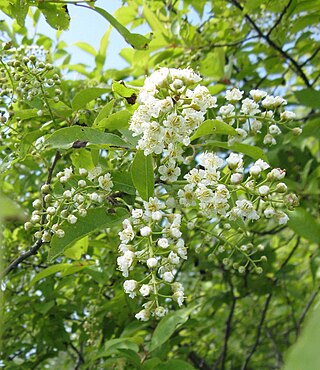
Umbellularia californica is a large hardwood tree native to coastal forests and the Sierra foothills of California, and to coastal forests extending into Oregon. It is endemic to the California Floristic Province. It is the sole species in the genus Umbellularia.

Prunus virginiana, commonly called bitter-berry, chokecherry, Virginia bird cherry, and western chokecherry, is a species of bird cherry native to North America.

Arctostaphylos uva-ursi is a plant species of the genus Arctostaphylos widely distributed across circumboreal regions of the subarctic Northern Hemisphere. Kinnikinnick is a common name in Canada and the United States. Growing up to 30 centimetres in height, the leaves are evergreen. The flowers are white to pink and the fruit is a red berry.

Myrica is a genus of about 35–50 species of small trees and shrubs in the family Myricaceae, order Fagales. The genus has a wide distribution, including Africa, Asia, Europe, North America, and South America, and missing only from Antarctica and Oceania. Some botanists split the genus into two genera on the basis of the catkin and fruit structure, restricting Myrica to a few species, and treating the others in Morella.

Myrica rubra, also called yangmei, yamamomo, Chinese bayberry, red bayberry, yumberry, waxberry, or Chinese strawberry is a subtropical tree grown for its fruit.

Aesculus californica, commonly known as the California buckeye or California horse-chestnut, is a species of buckeye native to California and southwestern Oregon.

Frangula californica is a species of flowering plant in the buckthorn family native to western North America. It produces edible fruits and seeds. It is commonly known as California coffeeberry and California buckthorn.

Aralia californica, known by the common name elk clover though not actually a clover, is a large herb in the family Araliaceae, the only member of the ginseng family native to California and southwestern Oregon. It is also called California aralia and California spikenard.
Bayberry wax is an aromatic green vegetable wax. It is removed from the surface of the fruit of the bayberry (wax-myrtle) shrub by boiling the fruits in water and skimming the wax from the surface of the water. It is made up primarily of esters of lauric, myristic, and palmitic acid.

Viburnum lantana, the wayfarer or wayfaring tree, is a species of Viburnum, native to central, southern and western Europe, northwest Africa, and southwestern Asia. The vigorous deciduous European treelike shrub is common along waysides.

Myrica pensylvanica, the northern bayberry, is a species of Myrica native to eastern North America, from Newfoundland west to Ontario and Ohio, and south to North Carolina. It is also classified as Morella pensylvanica.

Myrica cerifera is a small evergreen tree or large shrub native to North and Central America and the Caribbean. Its common names include southern wax myrtle, southern bayberry, candleberry, bayberry tree, and tallow shrub. It has uses in the garden and for candlemaking, as well as a medicinal plant.

Potentilla californica, also known as California horkelia, is a species of flowering plant in the rose family.

Myrica hartwegii, known by the common names Sierra sweet bay and Sierra bayberry, is a species of shrub in the bayberry family.
M. californica may refer to:
G. californica may refer to:

Ribes cereum is a species of currant known by the common names wax currant and squaw currant; the pedicellare variety is known as whisky currant. The species is native to western North America.

Myrica esculenta is a tree or large shrub of the tropics. The native range of this species stretches from Northern India (Uttarakhand) to Nepal to southern China and western and central Malesia. Its common names include box myrtle, bayberry and kaphal. Its berries are edible and are consumed locally.

Myrica inodora is a plant species native to the coastal plains on the northern shore of the Gulf of Mexico, in the Florida Panhandle, the extreme southern parts of Alabama and Mississippi, eastern Louisiana and southwestern Georgia. Common names include scentless bayberry, odorless bayberry, odorless wax-myrtle, waxberry, candleberry, and waxtree. It grows in swamps, bogs, pond edges and stream banks.

Myrica caroliniensis is a shrub or small tree native to the coast and coastal plains of southeastern North America. Its common names include bayberry, southern bayberry, pocosin bayberry, and evergreen bayberry. It sees uses in the garden and for candlemaking, as well as a medicinal plant.


















